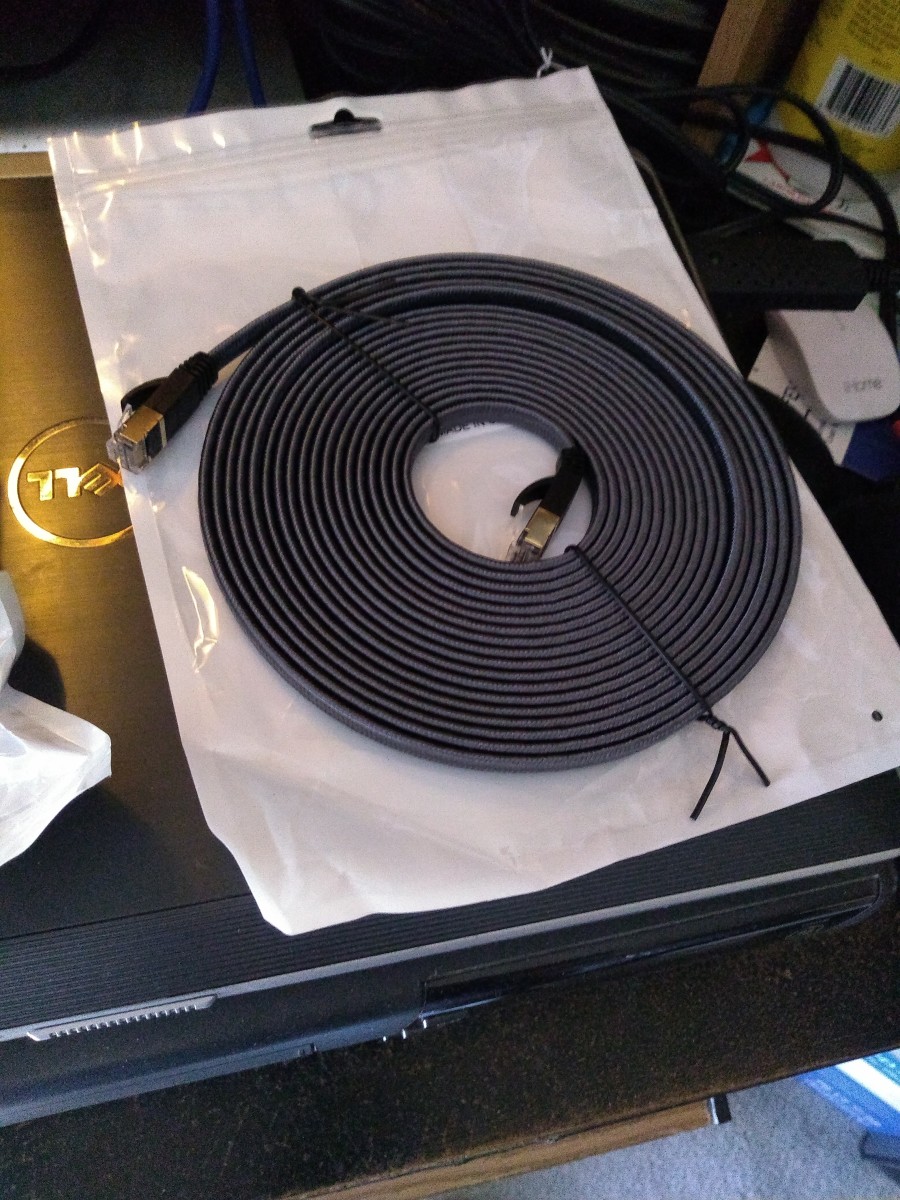The Cable Ratings Explained
The primary difference between cat5 (including cat5e), cat6, and cat7 is the amount and type of shielding. In short, the newer offerings have greater shielding against interference from outside sources, cross-talk from one pair of wires to another, and data loss. This additional shielding allows the products to rate the theoretical data transfer speeds higher. Ratings are in both throughput (megabits per second or Mbps) and frequency (megahertz or MHz). The frequency is just how fast the data on a pair of wires can change from one state to another.
Common Ethernet Cable Ratings at 100 meters of cable length
The Test Parameters
To conduct these tests, I started with my old setup: my trusty Dell Latitude 5580 laptop, a 10-year-old HP USB Hub, a TrendNet 24-port Gigabit Switch, a Netgear R6350 dual-band router, and an Arris cable modem provided by my cable company. The laptop connected to the USB Hub with the provided USB cable. This HUB connected to the switch, the router to the switch, and the router to the cable modem using generic cat5e cables I constructed myself several years ago. All of these cables were six feet in length. The first round of tests comprised three executions of the speed test from speedtest.net, which gives you the ping response time in milliseconds, and the download and upload speeds in megabits per second. The results are listed below.
Round 1 - Old setup with the USB HUB and cat5e cables
Round 2, USB Hub Removed
For round two of testing, the only change was to remove the USB hub from the configuration, and connect the switch directly to the laptop using the cat5e cable. The results showed a significant increase in download speed, indicating that the USB hub could be a bottleneck.
Cat5e cables, no USB Hub
Round 3 With New Cat7 Cables
For the third round, I replaced all the Cat5e cables with Cat7 cables. All of the cat5e cables were replaced with 10-foot Cat7 cables except for the one from the switch to the laptop. This is the one that will eventually be run under the floor, so the new cable is 20 feet long. So was there a significant increase in any of the measured results? In a word, no.
Round 3, new Cat7 cables, no USB Hub
Last Round, Re-add the USB Hub
For the fourth and final round, I re-inserted the USB hub between the laptop and the 24-port switch. As the results confirm, the hub does indeed negatively impact download speed.
Round 4, new Cat7 cables along with the USB Hub
Summing Up the Ethernet Cable Test Findings
So, at first blush we might find the fact that the new cables did not result in better upload or download speeds surprising, but there are actually good reasons for that. First of all, the service from our cable company probably limit us from seeing any results much better than 115 Mbps in any case. It is quite possible that if our service provided speeds approaching gigabits per second, the Cat7 cables might have been able to handle them far better than the old Cat5 ones. Also, if the environment had a lot of electronic “noise” in the form of strong wireless signals or interference from high tech devices, the signals in the Cat5 cables might suffer from measurable degradation that the Cat7 cables protect against. Finally, the relatively small number of runs over a very limited period of time doesn’t give us a real robust picture. It’s quite possible that the load on our local cable company’s infrastructure or the demand on the speedtest.net servers could significantly impact the results. The tests are of some value, however, in showing that for normal home or small business networks, all that extra shielding is probably not going to improve throughput very much, if at all. A final word on that USB hub that apparently costs my download speeds about 22 megabits per second. It is an older unit featuring USB 2.0. A newer Hub supporting USB 3.0 or better would almost certainly perform better. For now, I’m running without the hub in the mix for networking (although mouse, keyboard, and headset still connect that way).
Comments
Jeremy from Grand Blanc, MI on August 05, 2020: Jonathan Levitt - Was the 7 the same length as the 5? Signal attenuation is exponential. Jonathan Levitt on August 05, 2020: jerry7232020 on July 23, 2020: Ready?,,,speedtest.net used in all tests Have 3 year old hp desk top-connections direct from modem to computer-both tests below Had spectrum come in yesterday to boost my speed from 32 mg download 11.4 upload to 230mg download 11.4 upload used cat 5e Today did retest 14 ms 233.06 download and 11.5 upload switrched cat 7 flat cable 10 feet 10 ftU/FTP FLAT DESIGN CAT…RK PATCH CORD 10 FT 14ms 28.13 download 11.47 upload x 2= same results Tell me again the benefits of Cat7? Jeremy from Grand Blanc, MI on May 09, 2020: Let me know what you find out because down the road, I want to network this house for gaming so will be doing a lot of cable runs. Joe Poniatowskis (author) from Mid-Michigan on May 08, 2020: Right you are. What I might do is conduct some box-to-box file transfer tests within my own network to see if the different cables make a difference there. Maybe. Jeremy from Grand Blanc, MI on May 08, 2020: Judging by the frequency stats, it looks like the 7 should carry more bandwidth but not necessarily be substantially faster. However, due to the higher frequency, you can’t make as long of a cable run before you get cable loss (RF is fun shit). You stated in the summary that it could be because of the cable company, but if you ping to your gateway address at 192.X.X.X, then should it not matter what the cable co. offers/limits?
